turn signal JAGUAR S TYPE 1999 1.G Powertrain Manual
[x] Cancel search | Manufacturer: JAGUAR, Model Year: 1999, Model line: S TYPE, Model: JAGUAR S TYPE 1999 1.GPages: 75, PDF Size: 3.4 MB
Page 25 of 75

V6 Engine AJ-V6/AJ28
20to each VVT unit is supplied via fixed oilways in
the cylinder head and not through a separate
bush carrier. This arrangement requires a feed
through the camshaft side of the VVT unit from
the main cylinder head supply. The oil feed is
controlled by the VVT oil control valve, a solenoid
operated shuttle valve, which is bolted directly to
the cylinder head. From the oil control valve, the
flow is via the thrust bearing cap, through
drillings in the camshaft and then through the
hollow fixing bolt which secures the VVT unit.
Drain holes are provided at the rear (camside)
face of the VVT unit for any residual oil which has
seeped past the piston.
Operation
Operation is similar to that of the two stage V8
VVT system. With the oil control valve open, oil
pressure on the helical drive piston is increased,
rotating the cams to the advanced position.
When the valve closes, oil pressure reduces and
the return spring pushes the piston back to thefully retarded position.
The oil control valve is controlled by a 300Hz
PWM signal from the PCM which sets it to either
the fully open or fully closed position.
J.303.1306
VVT OPERATION
VVT Unit with
oil pressure
VVT oil
control valve
open
VVT oil
control valve
closed
VVT Unit with oil
pressure reduced
J.303.1306
Page 30 of 75
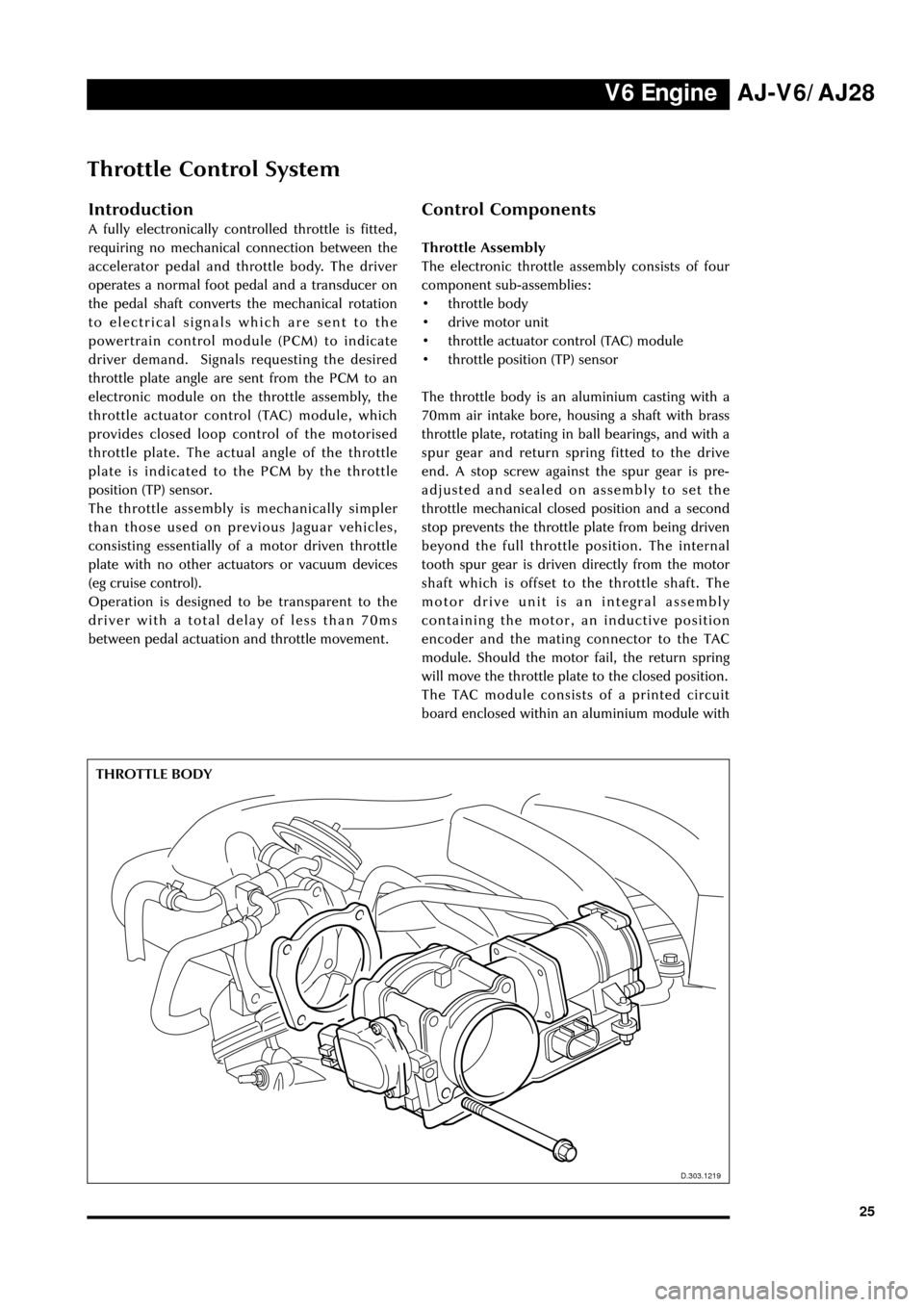
V6 EngineAJ-V6/AJ28
25
Throttle Control System
D.303.1219
Introduction
A fully electronically controlled throttle is fitted,
requiring no mechanical connection between the
accelerator pedal and throttle body. The driver
operates a normal foot pedal and a transducer on
the pedal shaft converts the mechanical rotation
to electrical signals which are sent to the
powertrain control module (PCM) to indicate
driver demand. Signals requesting the desired
throttle plate angle are sent from the PCM to an
electronic module on the throttle assembly, the
throttle actuator control (TAC) module, which
provides closed loop control of the motorised
throttle plate. The actual angle of the throttle
plate is indicated to the PCM by the throttle
position (TP) sensor.
The throttle assembly is mechanically simpler
than those used on previous Jaguar vehicles,
consisting essentially of a motor driven throttle
plate with no other actuators or vacuum devices
(eg cruise control).
Operation is designed to be transparent to the
driver with a total delay of less than 70ms
between pedal actuation and throttle movement.
THROTTLE BODY
Control Components
Throttle Assembly
The electronic throttle assembly consists of four
component sub-assemblies:
¥ throttle body
¥ drive motor unit
¥ throttle actuator control (TAC) module
¥ throttle position (TP) sensor
The throttle body is an aluminium casting with a
70mm air intake bore, housing a shaft with brass
throttle plate, rotating in ball bearings, and with a
spur gear and return spring fitted to the drive
end. A stop screw against the spur gear is pre-
adjusted and sealed on assembly to set the
throttle mechanical closed position and a second
stop prevents the throttle plate from being driven
beyond the full throttle position. The internal
tooth spur gear is driven directly from the motor
shaft which is offset to the throttle shaft. The
motor drive unit is an integral assembly
containing the motor, an inductive position
encoder and the mating connector to the TAC
module. Should the motor fail, the return spring
will move the throttle plate to the closed position.
The TAC module consists of a printed circuit
board enclosed within an aluminium module with
D.303.1219
Page 31 of 75
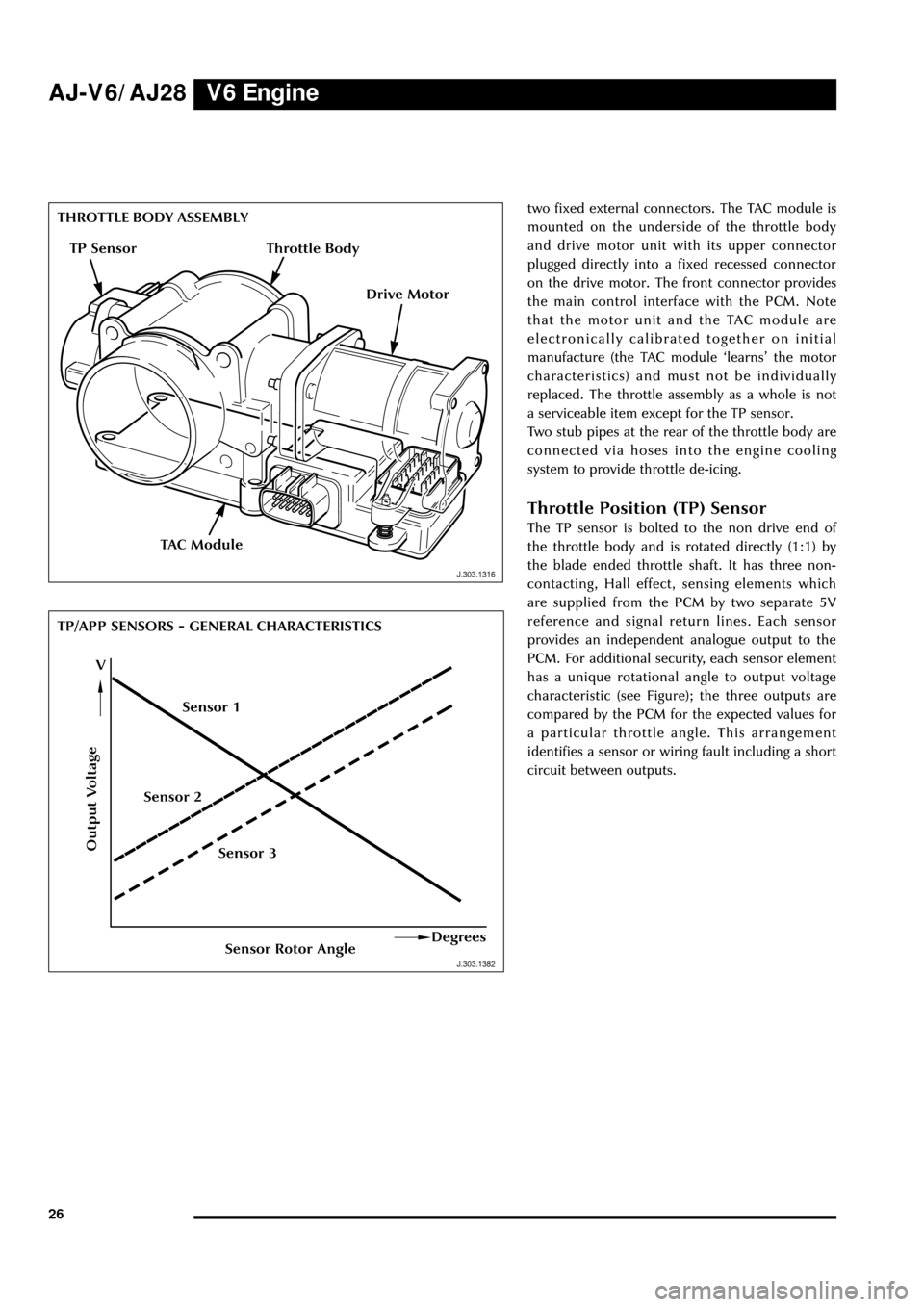
V6 Engine AJ-V6/AJ28
26
J.303.1316
J.303.1362
THROTTLE BODY ASSEMBLY
TP/APP SENSORS - GENERAL CHARACTERISTICStwo fixed external connectors. The TAC module is
mounted on the underside of the throttle body
and drive motor unit with its upper connector
plugged directly into a fixed recessed connector
on the drive motor. The front connector provides
the main control interface with the PCM. Note
that the motor unit and the TAC module are
electronically calibrated together on initial
manufacture (the TAC module ÔlearnsÕ the motor
characteristics) and must not be individually
replaced. The throttle assembly as a whole is not
a serviceable item except for the TP sensor.
Two stub pipes at the rear of the throttle body are
connected via hoses into the engine cooling
system to provide throttle de-icing.
Throttle Position (TP) Sensor
The TP sensor is bolted to the non drive end of
the throttle body and is rotated directly (1:1) by
the blade ended throttle shaft. It has three non-
contacting, Hall effect, sensing elements which
are supplied from the PCM by two separate 5V
reference and signal return lines. Each sensor
provides an independent analogue output to the
PCM. For additional security, each sensor element
has a unique rotational angle to output voltage
characteristic (see Figure); the three outputs are
compared by the PCM for the expected values for
a particular throttle angle. This arrangement
identifies a sensor or wiring fault including a short
circuit between outputs.
Output Voltage
Sensor Rotor AngleDegrees
V
TAC Module
J.303.1382 J.303.1316
TP Sensor
Drive Motor
Sensor 3 Sensor 2Sensor 1
Throttle Body
Page 32 of 75
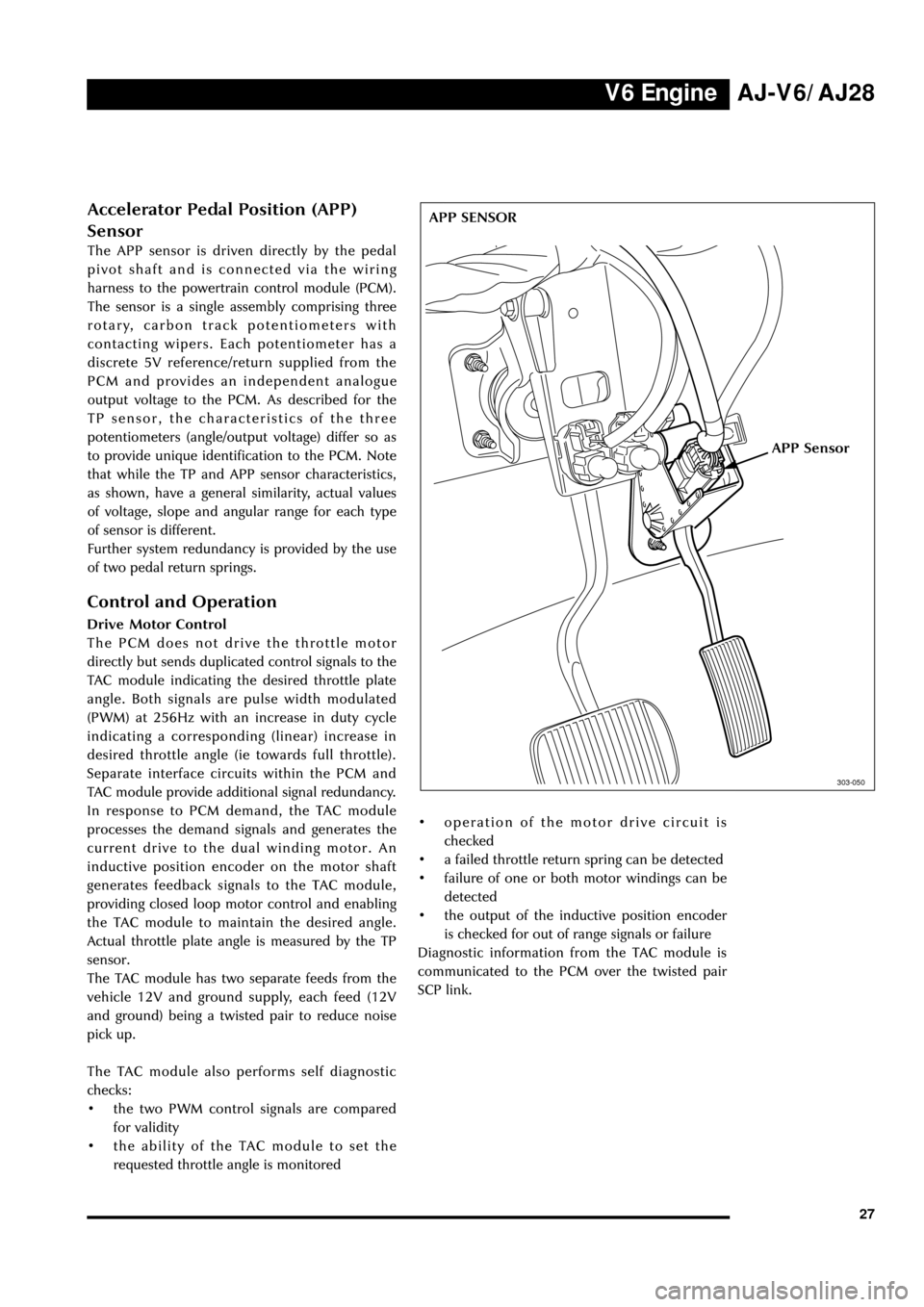
V6 EngineAJ-V6/AJ28
27
D.418.428
APP Sensor
303-050
APP SENSORAccelerator Pedal Position (APP)
Sensor
The APP sensor is driven directly by the pedal
pivot shaft and is connected via the wiring
harness to the powertrain control module (PCM).
The sensor is a single assembly comprising three
rotary, carbon track potentiometers with
contacting wipers. Each potentiometer has a
discrete 5V reference/return supplied from the
PCM and provides an independent analogue
output voltage to the PCM. As described for the
TP sensor, the characteristics of the three
potentiometers (angle/output voltage) differ so as
to provide unique identification to the PCM. Note
that while the TP and APP sensor characteristics,
as shown, have a general similarity, actual values
of voltage, slope and angular range for each type
of sensor is different.
Further system redundancy is provided by the use
of two pedal return springs.
Control and Operation
Drive Motor Control
The PCM does not drive the throttle motor
directly but sends duplicated control signals to the
TAC module indicating the desired throttle plate
angle. Both signals are pulse width modulated
(PWM) at 256Hz with an increase in duty cycle
indicating a corresponding (linear) increase in
desired throttle angle (ie towards full throttle).
Separate interface circuits within the PCM and
TAC module provide additional signal redundancy.
In response to PCM demand, the TAC module
processes the demand signals and generates the
current drive to the dual winding motor. An
inductive position encoder on the motor shaft
generates feedback signals to the TAC module,
providing closed loop motor control and enabling
the TAC module to maintain the desired angle.
Actual throttle plate angle is measured by the TP
sensor.
The TAC module has two separate feeds from the
vehicle 12V and ground supply, each feed (12V
and ground) being a twisted pair to reduce noise
pick up.
The TAC module also performs self diagnostic
checks:
¥ the two PWM control signals are compared
for validity
¥ the ability of the TAC module to set the
requested throttle angle is monitored¥ operation of the motor drive circuit is
checked
¥ a failed throttle return spring can be detected
¥ failure of one or both motor windings can be
detected
¥ the output of the inductive position encoder
is checked for out of range signals or failure
Diagnostic information from the TAC module is
communicated to the PCM over the twisted pair
SCP link.
Page 34 of 75
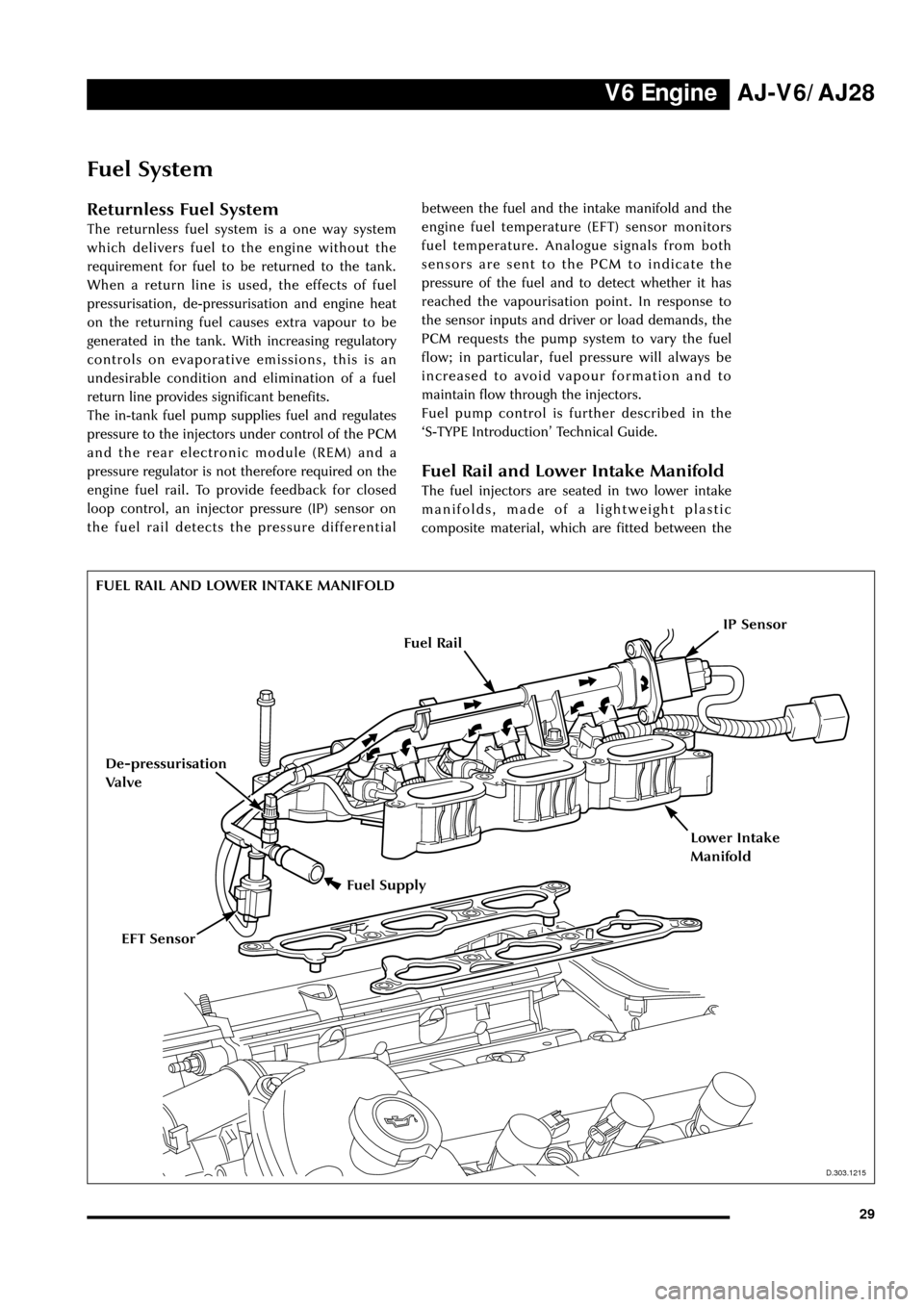
V6 EngineAJ-V6/AJ28
29
D.303.1215
FUEL RAIL AND LOWER INTAKE MANIFOLD
Fuel Supply
D.303.1215
EFT Sensor
De-pressurisation
Valve
IP Sensor
Fuel System
Returnless Fuel System
The returnless fuel system is a one way system
which delivers fuel to the engine without the
requirement for fuel to be returned to the tank.
When a return line is used, the effects of fuel
pressurisation, de-pressurisation and engine heat
on the returning fuel causes extra vapour to be
generated in the tank. With increasing regulatory
controls on evaporative emissions, this is an
undesirable condition and elimination of a fuel
return line provides significant benefits.
The in-tank fuel pump supplies fuel and regulates
pressure to the injectors under control of the PCM
and the rear electronic module (REM) and a
pressure regulator is not therefore required on the
engine fuel rail. To provide feedback for closed
loop control, an injector pressure (IP) sensor on
the fuel rail detects the pressure differentialbetween the fuel and the intake manifold and the
engine fuel temperature (EFT) sensor monitors
fuel temperature. Analogue signals from both
sensors are sent to the PCM to indicate the
pressure of the fuel and to detect whether it has
reached the vapourisation point. In response to
the sensor inputs and driver or load demands, the
PCM requests the pump system to vary the fuel
flow; in particular, fuel pressure will always be
increased to avoid vapour formation and to
maintain flow through the injectors.
Fuel pump control is further described in the
ÔS-TYPE IntroductionÕ Technical Guide.
Fuel Rail and Lower Intake Manifold
The fuel injectors are seated in two lower intake
manifolds, made of a lightweight plastic
composite material, which are fitted between the
Fuel Rail
Lower Intake
Manifold
Page 74 of 75
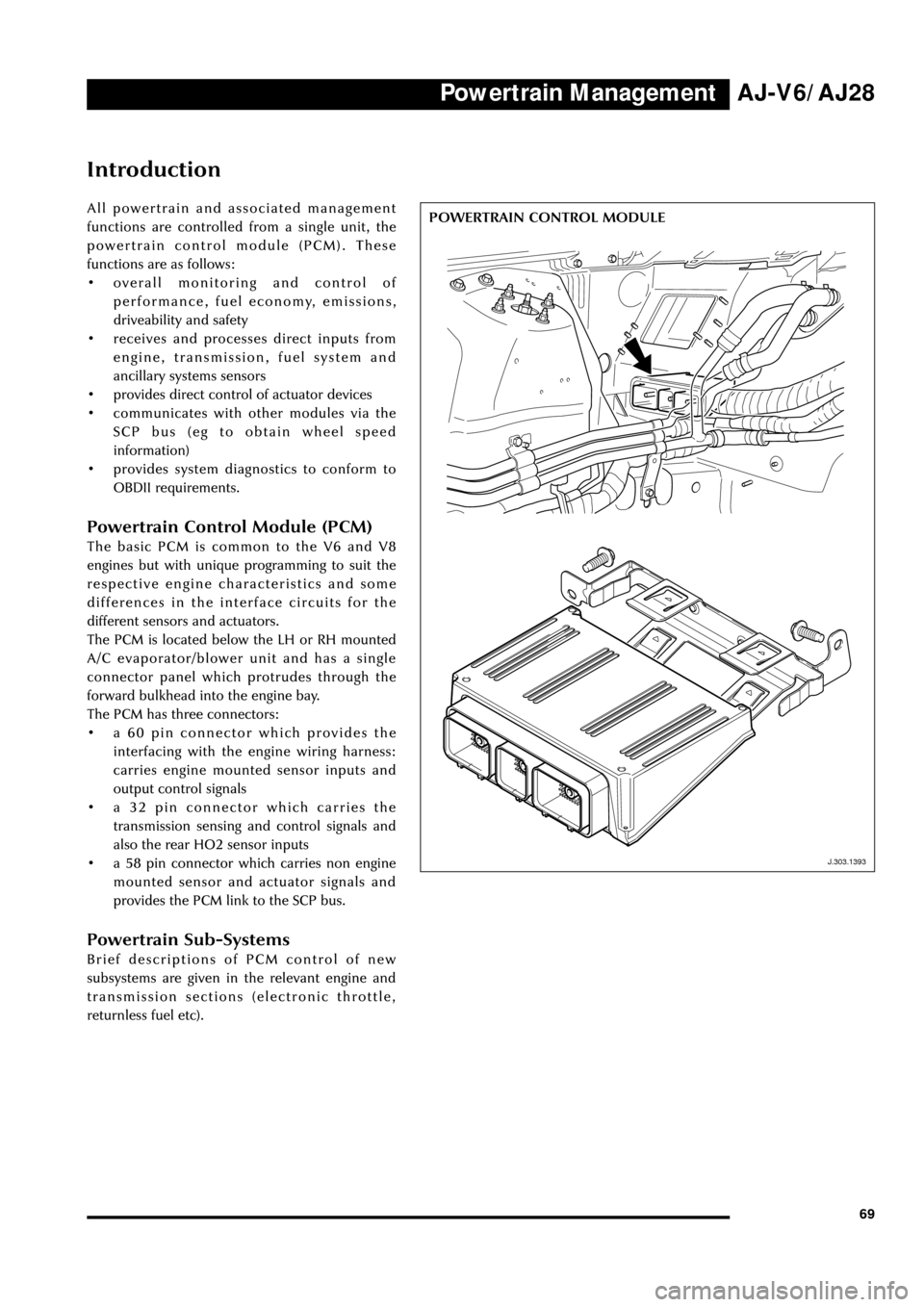
Powertrain ManagementAJ-V6/AJ28
69
Introduction
All powertrain and associated management
functions are controlled from a single unit, the
powertrain control module (PCM). These
functions are as follows:
¥ overall monitoring and control of
performance, fuel economy, emissions,
driveability and safety
¥ receives and processes direct inputs from
engine, transmission, fuel system and
ancillary systems sensors
¥ provides direct control of actuator devices
¥ communicates with other modules via the
SCP bus (eg to obtain wheel speed
information)
¥ provides system diagnostics to conform to
OBDII requirements.
Powertrain Control Module (PCM)
The basic PCM is common to the V6 and V8
engines but with unique programming to suit the
respective engine characteristics and some
differences in the interface circuits for the
different sensors and actuators.
The PCM is located below the LH or RH mounted
A/C evaporator/blower unit and has a single
connector panel which protrudes through the
forward bulkhead into the engine bay.
The PCM has three connectors:
¥ a 60 pin connector which provides the
interfacing with the engine wiring harness:
carries engine mounted sensor inputs and
output control signals
¥ a 32 pin connector which carries the
transmission sensing and control signals and
also the rear HO2 sensor inputs
¥ a 58 pin connector which carries non engine
mounted sensor and actuator signals and
provides the PCM link to the SCP bus.
Powertrain Sub-Systems
Brief descriptions of PCM control of new
subsystems are given in the relevant engine and
transmission sections (electronic throttle,
returnless fuel etc).
J.303.1393
POWERTRAIN CONTROL MODULE
J.303.1393